

Tyrosine. Functions[edit] Aside from being a proteinogenic amino acid, tyrosine has a special role by virtue of the phenol functionality.
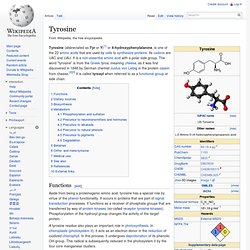
It occurs in proteins that are part of signal transduction processes. It functions as a receiver of phosphate groups that are transferred by way of protein kinases (so-called receptor tyrosine kinases). Phosphorylation of the hydroxyl group changes the activity of the target protein. A tyrosine residue also plays an important role in photosynthesis. Dietary sources[edit] Biosynthesis[edit] In plants and most microorganisms, tyr is produced via prephenate, an intermediate on the shikimate pathway.
Mammals synthesize tyrosine from the essential amino acid phenylalanine (phe), which is derived from food. [edit] Conversion of phenylalanine and tyrosine to its biologically important derivatives. Phosphorylation and sulfation[edit] Some of the tyrosine residues can be tagged with a phosphate group (phosphorylated) by protein kinases. Serine. Serine (abbreviated as Ser or S)[3] is an amino acid with the formula HO2CCH(NH2)CH2OH.
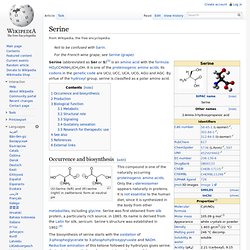
It is one of the proteinogenic amino acids. Its codons in the genetic code are UCU, UCC, UCA, UCG, AGU and AGC. By virtue of the hydroxyl group, serine is classified as a polar amino acid. Occurrence and biosynthesis[edit] (S)-Serine (left) and (R)-serine (right) in zwitterionic form at neutral pH This compound is one of the naturally occurring proteinogenic amino acids. The biosynthesis of serine starts with the oxidation of 3-phosphoglycerate to 3-phosphohydroxypyruvate and NADH. This compound may also be naturally produced when UV light illuminates simple ices such as a combination of water, methanol, hydrogen cyanide, and ammonia, suggesting that it may be easily produced in cold regions of space.[6] Proline. Biosynthesis[edit] Proline is biosynthetically derived from the amino acid L-glutamate.
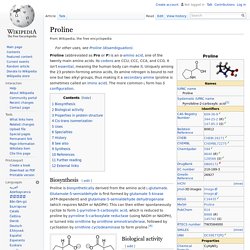
Glutamate-5-semialdehyde is first formed by glutamate 5-kinase (ATP-dependent) and glutamate-5-semialdehyde dehydrogenase (which requires NADH or NADPH). Glycine. Glycine (abbreviated as Gly or G)[4] is an organic compound with the formula NH2CH2COOH.
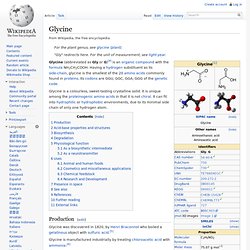
Having a hydrogen substituent as its side-chain, glycine is the smallest of the 20 amino acids commonly found in proteins. Its codons are GGU, GGC, GGA, GGG of the genetic code. Production[edit] Glycine was discovered in 1820, by Henri Braconnot who boiled a gelatinous object with sulfuric acid.[5] Glycine is manufactured industrially by treating chloroacetic acid with ammonia:[6] ClCH2COOH + 2 NH3 → H2NCH2COOH + NH4Cl About 15 million kg are produced annually in this way.[7] In the USA (by GEO Specialty Chemicals, Inc.) and in Japan (by Showa Denko, K.K.)Showa Denko America, glycine is produced via the Strecker amino acid synthesis.[8][9] Acid-base properties and structures[edit] Both isomers of glycine have been observed by microwave spectroscopy in the gas phase.[12] The solid-state structure has been analyzed in detail.[13] Biosynthesis[edit] Glycine is coded by codons GGU, GGC, GGA and GGG.
Glutamine. Glutamine (abbreviated as Gln or Q) is one of the 20 amino acids encoded by the standard genetic code.

It is not recognized as an essential amino acid. Its side-chain is an amide formed by replacing the side-chain hydroxyl of glutamic acid with an amine functional group, making it the amide of glutamic acid. Its codons are CAA and CAG. In human blood, glutamine is the most abundant free amino acid, with a concentration of about 500–900 µmol/l.[2] Structure[edit] Glutamine zwitterionic forms at neutral pH: L-glutamine (left) and D-glutamine. Cysteine. Arginine. Arginine (/ˈɑrɡɪniːn/, abbreviated as Arg or R)[1] is an α-amino acid.
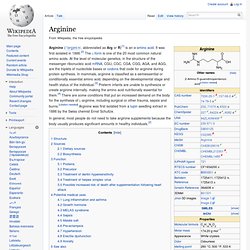
It was first isolated in 1886.[2] The L-form is one of the 20 most common natural amino acids. At the level of molecular genetics, in the structure of the messenger ribonucleic acid mRNA, CGU, CGC, CGA, CGG, AGA, and AGG, are the triplets of nucleotide bases or codons that code for arginine during protein synthesis. In mammals, arginine is classified as a semiessential or conditionally essential amino acid, depending on the developmental stage and health status of the individual.[3] Preterm infants are unable to synthesize or create arginine internally, making the amino acid nutritionally essential for them.[4] There are some conditions that put an increased demand on the body for the synthesis of L-arginine, including surgical or other trauma, sepsis and burns. [citation needed] Arginine was first isolated from a lupin seedling extract in 1886 by the Swiss chemist Ernst Schultze.